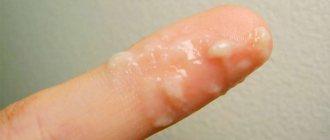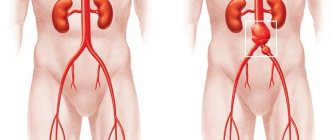Polycystic ovary syndrome (PCOS) is an endocrine structural and functional pathology in which multiple small and large cysts form in the glandular tissue of the organ. They are modified eggs that have matured but did not leave the ovary due to lack of ovulation. As a result of such processes, the ovaries increase in size, their surface becomes lumpy.
PCOS is a manifestation of a whole complex of hormonal disorders occurring in the body. Ovarian dysfunction is usually combined with pathology of other endocrine glands - thyroid, pancreas, adrenal glands, pituitary gland, hypothalamus. Due to hormonal disorders occurring in the female body, multiple small cysts—vesicles filled with fluid—begin to form and grow on the surface of the ovaries. This is due to the overproduction of the male sex hormone - androgen. Under its influence, the eggs remain in the follicles, which gradually turn into cysts.
The disease can be asymptomatic or manifest as oligomenorrhea, hirsutism, abdominal obesity, and skin acne. Over time, secondary male sexual characteristics include: type 2 diabetes mellitus, heart attacks and strokes. In the absence of timely treatment, the syndrome leads to spontaneous abortion and infertility.
Polycystic ovary syndrome is a multifactorial heterogeneous pathology that most often develops in teenage girls. During menopause, secondary polycystic ovary syndrome appears, caused by long-term inflammation of the female genital organs. Chronic inflammation of the ovaries leads to the formation of cysts filled with fluid and immature eggs.
Main criteria of pathology:
- Chronic lack of ovulation,
- Hyperandrogenism,
- Ovarian hypertrophy on both sides,
- Proliferation of glandular stroma with luteinization processes,
- Subcapsular arrangement of cystic formations in the form of a “necklace”,
- Compaction of the follicle capsule.
Polycystic ovary syndrome has several equivalent names: Stein-Leventhal syndrome, polycystic ovary syndrome, functional ovarian hyperandrogenism. The disease is equally common in different ethnic groups.
Forms of pathology:
- The primary or congenital form occurs in adolescence, when the menstrual cycle begins to form. True PCOS develops in girls with normal weight and blood glucose concentration, is severe and difficult to treat.
- The secondary form develops in mature women suffering from inflammatory diseases of the genital organs or chronic endocrinopathy. Secondary PCOS occurs predominantly in individuals with obesity and hyperglycemia.
According to ultrasound of the ovaries, diffuse and peripheral polycystic disease are distinguished:
- Diffuse polycystic disease - follicles are scattered in the stroma of the organ. This form develops in women with normal weight, mild manifestations of hirsutism and secondary amenorrhea.
- Peripheral localization of follicles is characteristic of the classic form of PCOS. Cysts are located along the edge of the stroma and have the appearance of a necklace. A similar picture occurs in women with obesity and a history of spontaneous abortion.
Causes of polycystic ovary syndrome
Polycystic ovary syndrome appears against the background of hormonal disorders in a woman’s body. The disease develops according to the following scheme:
- the male hormone androgen is produced in excessive quantities;
- female hormones progesterone and estrogen are produced in insufficient quantities;
- a conflict begins between the endocrine system and the ovaries;
- the formed egg is not able to leave the follicle;
- the surface of the ovary is covered with small cysts.
There are many reasons for the occurrence of the pathological process. Most often, the disease affects women who are at risk for hormonal disorders:
- Close relatives on the female side had or have PCOS. Pathologies of the pelvic organs can be inherited;
- there are diseases of the endocrine system;
- the presence of endometriosis or uterine fibroids;
- past or current infectious diseases. Some inflammatory processes in the body can provoke hormonal imbalance, dysfunction of the pelvic organs;
- excessive physical activity;
- long-term experience of psycho-emotional shocks. The psychological factor significantly affects a woman’s immunity and hormonal levels;
- unfavorable environmental conditions;
- metabolic pathologies;
- excess weight;
- sudden change in climatic conditions.
All of the above factors affect the formation of the egg and can provoke polycystic ovary syndrome. In the event of a negative impact on the ovulation process, the follicle shell thickens and the next stage is not the release of the egg for fertilization, but the formation of cysts.
Causes
Currently, in official medicine there is no specific data regarding the causes of the syndrome. It is believed that they remain not fully studied. PCOS is a manifestation of polyendocrine disorders occurring in the female body.
Hyperandrogenism and hypoprogesteronemia are common causes of hormonal imbalance in a woman’s body. Maintaining certain relationships between the ovaries, the anterior pituitary gland and the hypothalamus ensures adequate functioning of the reproductive system. If this interaction is disrupted, PCOS may develop.
Factors contributing to the development of the syndrome:
- Genetic predisposition,
- Excess weight,
- Diabetes,
- Hypofunction of the thyroid gland,
- Acute infectious diseases,
- Inflammatory diseases of the female genital organs,
- Autoimmune processes
- Stress,
- Climate change
- Abnormal fetal development.
Pathogenetic links of the syndrome:
- Insulin resistance of adipose and muscle tissue,
- Circulation of insulin in the blood
- Compensatory hyperinsulinemia,
- Ovarian stimulation,
- Hyperandrogenism,
- Ovarian dysfunction,
- Anovulation,
- Thickening of the ovarian membrane,
- Filling the follicle with fluid,
- Cyst formation,
- Menstrual dysfunction and infertility.
In this case, the ovaries are of normal size or slightly enlarged, their capsule is smooth and thickened. They contain small follicular brushes and large cysts with many atretic cells. Numerous ovarian cysts have a “pearl necklace” appearance. The ovarian capsule is compacted and pearly white. Hyperestrogenemia leads to endometrial hyperplasia, and subsequently to cancer.
PCOS is a multifactorial and genetically determined disease, the pathogenesis of which involves central and local mechanisms of endocrine regulation, as well as metabolic disorders. Together they determine the clinical picture of the pathology and morphological changes in the glandular tissue of the ovaries.
Symptoms
Stein Leventhal syndrome occurs with obvious symptoms, which allow the patient to independently suspect the development of the disease.
The most common symptoms of polycystic ovary syndrome:
- Irregularity of the menstrual cycle, absence of critical days. Often a woman experiences heavy bleeding during menstruation or its absence for several cycles. This is a hallmark of PCOS and is present in 95% of patients;
- pronounced work of the sebaceous glands of the skin of the face, back, and hair areas. The problem is accompanied by the appearance of acne;
- weight gain. Excess body weight appears against the background of hormonal disorders of the endocrine system. In the case of pathology, a sharp weight gain in a short period of time is characteristic;
- hair loss in the scalp area. Baldness occurs due to excessive production of the hormone androgen, which leads to male pattern hair loss;
- pain syndrome in the lower abdomen. This is one of the clear signs of the presence of diseases of the genitourinary system and polycystic ovary syndrome. Often the pain radiates to the lower back or tailbone;
- changes in the figure according to the male type. Accompanied by an increase in muscles in the shoulders and arms;
- hair on the chest, face, legs, stomach (see photo above). Increased hairiness is caused by the male hormone androgen. The presence of coarse, thick and dark hair in places not intended for this is a cause for concern;
- emotional disturbances. A woman who suffers from polycystic ovary syndrome suffers from bouts of depression. There is nervousness, lack of restraint, aggressiveness;
- loss of performance, attention and concentration. Patients with PCOS often complain of drowsiness and decreased activity;
- severe premenstrual syndrome. PMS includes irritability, severe pain in the lower abdomen, lower back, nausea, dizziness, swelling in the legs, breast enlargement and tenderness;
- infertility. A diagnosis of PCOS leads to a decrease in the ability to become pregnant. Cystic formations do not allow the egg to fully exit the follicle, which deprives the woman of regular ovulation. A patient is diagnosed with infertility if she has unsuccessfully tried to get pregnant for 6 months.
In case of successful conception, there is a high probability of miscarriage or premature birth, since the hormonal background does not react correctly to the onset of pregnancy.
Symptoms of PCOS
The symptoms of PCOS are varied. The first thing a woman usually notices is irregular periods. Delays in menstruation with PCOS can be months or even six months. Since disruption of the hormonal function of the ovaries begins with puberty, cycle disturbances begin with menarche and do not tend to normalize. It should be noted that the age of menarche corresponds to that in the population - 12-13 years (in contrast to adrenal hyperandrogenism in adrenogenital syndrome, when menarche is delayed). In approximately 10-15% of patients, menstrual irregularities are characterized by dysfunctional uterine bleeding against the background of endometrial hyperplastic processes. Therefore, women with PCOS are at risk of developing endometrial adenocarcinoma, fibrocystic mastopathy and breast cancer.
The mammary glands are developed correctly, every third woman has fibrocystic mastopathy, which develops against the background of chronic anovulation and hyperestrogenism.
In addition to menstrual irregularities, increased levels of male hormones cause increased hair growth throughout the body (hirsutism). The skin becomes oily, pimples and blackheads appear on the face, back, and chest. Characteristic is the appearance of dark brown spots on the skin on the inner thighs, elbows, and armpits. The hair on the head quickly becomes oily due to impaired function of the sebaceous glands. Hirsutism, of varying severity, develops gradually from the period of menarche, in contrast to adrenogenital syndrome, when hirsutism develops before menarche, from the moment of activation of the hormonal function of the adrenal glands during the period of adrenarche.
Almost all patients with PCOS have increased body weight. In this case, excess fat is deposited, as a rule, on the abdomen (“central” type of obesity). Since insulin levels are elevated in PCOS, the disease is often combined with type 2 diabetes. PCOS contributes to the early development of vascular diseases such as hypertension and atherosclerosis.
And finally, one of the main and unpleasant symptoms of PCOS is infertility due to lack of ovulation. Most often, infertility is primary (in 85% of cases), i.e. There have never been any pregnancies. Sometimes infertility is the only symptom of polycystic ovary syndrome. Infertility is primary in nature, in contrast to adrenal hyperandrogenism, in which pregnancy is possible and is characterized by miscarriage.
Since there are many symptoms of the disease, PCOS can easily be confused with any dyshormonal disorder. At a young age, oily skin, acne and pimples are mistaken for natural age-related features, while increased hairiness and excess weight problems are often perceived as genetic features. Therefore, if the menstrual cycle is not disrupted and the woman has not yet tried to become pregnant, then such patients rarely turn to a gynecologist. It is important to know that any such manifestations are not the norm and if you discover similar symptoms, you should consult a gynecologist-endocrinologist in person.
Diagnostics
Diagnostic measures for polycystic ovary syndrome include the following methods:
- initial examination of the patient: skin condition, body type and hair growth, palpation of the lower abdomen;
- examination on a gynecological chair: assessment of the condition of the vagina, palpation of the ovaries, uterus;
- taking a smear to identify the infectious component and determine the vaginal flora;
- conducting ultrasound diagnostics of the pelvic organs: assessment of blood flow, size of ovaries, follicles;
- blood test for hormones: the amount of ovarian and endocrine system hormones is determined;
- MRI: prescribed for suspected malignancy;
- blood test to assess metabolic processes in the body: the level of lipids and their fractions, the amount of glucose and insulin;
- Laparoscopy: the most informative diagnostic method for PCOS, it allows you to determine the stage of the pathology and take the necessary material for histological examination.
PCOS in gynecology is diagnosed when a woman’s menstrual cycle is disrupted and there are cystic changes in the ovaries. Often, a specialist can diagnose PCOS based on the patient’s complaints and examination.
Causes and risk factors of PCOS
The basis underlying the development of PCOS is various endocrine disorders. Moreover, various deviations are observed not in one, but in several organs at once. Most often noted:
- improper regulation of the adrenal glands and ovaries even at the level of the pituitary gland or hypothalamus;
- improper functioning of the adrenal cortex, due to which they produce a very large amount of androgens, which negatively affect the functioning of the ovaries;
- malfunctions in the functioning of the ovaries themselves (improper secretion of estrogens and, as a consequence, the appearance of disturbances in the structure of the organ);
- improper functioning of the pancreas, in which it secretes a lot of insulin, and body tissues lose sensitivity to it.
Risk factors that increase the likelihood of developing PCOS include:
- obesity;
- excess insulin;
- traumatic brain injuries;
- diseases of the pituitary gland and hypothalamus;
- adrenal gland diseases;
- constant negative psycho-emotional effects;
- diseases of the reproductive system.
Since the ovaries, being an organ of the endocrine system, are themselves forced to obey other hormones produced by higher-ranking organs, it turns out that PCOS develops mainly as a multifactorial disease. At the same time, incorrect hormonal regulation over time leads to the fact that the ovarian capsule becomes denser, the follicles cease to develop correctly, and this, in turn, leads to the formation of cysts.
The cause of endocrine disorders that lead to the development of PCOS can be any negative impact on the body. Stress, dramatic climate change, acute or chronic infectious diseases can lead to the endocrine system organs stopping working in accordance with the body's demands.
Photo: comparison of a healthy ovary and an ovary with PCOS
Treatment of polycystic ovary syndrome
Treatment of PCOS is planned by a specialist based on the individual characteristics of the patient and the course of the disease. The sequence of actions depends on the woman’s excess weight.
| Stage | Method | Description |
| For overweight | ||
| 1) Reducing body weight to normal levels. | Dietary food that is necessary to normalize the metabolic process. | Reduce your kcal intake to 2000 per day. It is necessary to completely eliminate spicy and salty foods from the diet. It is forbidden to lose weight by fasting. |
| 2) Restoration of metabolism. | Drug therapy. Prescribed in case of lack of the expected effect from dietary nutrition and physical activity. | Metmorphine : 1500 mg per day. The course of treatment lasts from 3 to 6 months. Throughout the entire treatment phase, it is necessary to undergo a glucose tolerance test. |
| With normal body weight | ||
| 1) Stimulation of ovulation. | Drug therapy and polycystic ovary syndrome. It is carried out only after excluding other causes of infertility (male or tubal infertility) and normalizing the patient’s weight. | Clomiphene : from 5 to 9 days of the menstrual cycle. The dosage is 50 mg per day. If, according to the results of the examination, ovulation was not achieved, then the dose of the drug is increased by 50 mg in each cycle. The maximum dosage is 200 mg. |
| Surgical method. Wedge resection of the ovaries. Surgery against PCOS in gynecology is necessary in the absence of results of treatment with medications. The presence of tubal infertility in combination with PCOS is also an indication for resection. | It is carried out using a special laparoscope apparatus. The method is low-traumatic and eliminates the possibility of multiple pregnancies. Wedge resection involves removal of the steroid-producing ovarian stroma. In the postoperative period, it is necessary to exclude physical strain, including constipation. | |
| 2) Prevention of PCOS | Prescribed several years after ovarian resection or pregnancy. Prevention is also necessary after stimulating ovulation using medication if the woman is not planning a pregnancy. | Duphaston : in a dosage of 20 mg starting from the 16th day of the cycle to the 25th day. Diane-35: take according to the regimen for six months to 3 years. |
The main goal in the treatment of PCOS is to restore ovulation and ensure the possibility of fertilization of the egg.
If polycystic ovary syndrome is mild and has no indication for surgery, a specialist may prescribe antiandrogen-type oral contraceptives as treatment.
Attention! Treatment against PCOS should only be prescribed by a qualified specialist. Uncontrolled use of medications can lead to persistent metabolic and hormonal imbalances and chronic infertility.
ethnoscience
Polycystic ovaries can be treated with homemade remedies after the permission of the attending physician, in combination with basic drug therapy.
Therapeutic tampon. To prepare you will need mumiyo, a bandage and warm water. 100 gr. Shilajit powder should be diluted with clean water until creamy. Twist a tampon from a bandage, generously lubricate it with the resulting mixture and place it in the vagina for 1 hour. If polycystic ovary syndrome is diagnosed, treatment should continue for 7 days. It is necessary to observe the dosage of mumiyo when preparing. Excessive or prolonged use of the product will lead to the opposite result, inflammatory processes and pain.
Borovaya uterus. The herb is taken as an infusion. For cooking you need 10 grams. Pour a glass of boiling water over crushed dry grass of the boron uterus. Let it brew for 1.5 hours. Drink in small sips throughout the day. The course of treatment is 3 weeks. The plant loses its effectiveness when infused with alcohol. Borovaya uterus has anti-inflammatory properties, restores the functioning of the ovaries and improves the condition of the inner layer of the uterus.
Red brush against PCOS. You will need 5 tablespoons of dried red brush and 0.5 liters of vodka. Pour the vodka into a dark glass container and add a red brush. Place the mixture in a dark place. Leave for 7 days. The course of treatment is 2 weeks. Take 1 teaspoon per day before meals. The red brush helps restore normal functioning of the female genitourinary system and has a beneficial effect on the tissues of the genital organs.
Comprehensive collection against PCOS. To prepare, you will need 1 tablespoon each of the herbs mint, rose hips, dandelion and nettle. Pour the mixture with 2 cups of boiling water and let it brew for 2 hours. Take 1 tablespoon 5 times a day. Store the infusion in the refrigerator for no more than 2 days.
Basil tincture. To prepare, add 1 cup of boiling water to 3 tablespoons of basil. Boil over low heat for 15 minutes. Next, let it brew. Cool the infusion and strain through cheesecloth. Store in the refrigerator for no more than 2 days. Take 0.5 cups per day before lunch. The plant has a positive effect on the woman’s reproductive system, inhibits the harmful effects of pathogens and inhibits the production of male hormones.
Linen. Pour 1 teaspoon of flax seeds into a glass of boiling water and leave for at least 10 minutes. Next, cool the broth, strain and drink 3 sips before meals 4 times a day. It is not recommended to take the drug during an exacerbation of PCOS. The plant helps improve immunity and saturate the body with nutrients.
Treatment based on traditional medicine cannot be used in the presence of malignant tumors. Any course of treatment can be repeated after 30 days for 6 months.
Before using the products, you need to make sure that there is no allergic reaction to the components included in the composition.
Physical exercise
Before engaging in fitness or physical education, it is worth remembering that excessive physical activity is contraindicated for women with polycystic ovary syndrome. Involvement in heavy sports leads to an increase in the production of the male hormone testosterone.
There is a list of exercises that help normalize hormonal levels and metabolism:
- light jogging, brisk walking and exercise bike. Alternate one after another 3 times a week. Exercise for no more than 1 hour;
- strength training under the supervision of a trainer. Repeat 2 times a week. A moderate gain of muscle mass will eliminate excess insulin and glucose and stimulate metabolism;
- yoga. Helps calm the emotional background and reduce insulin production.
If there was no previous physical training, then the load must be increased gradually.
Operation
The indication for surgical treatment of polycystic ovary syndrome is the lack of effect of conservative therapy. The method of operation is determined depending on the picture of the disease. In women with infertility, surgical treatment is an analogue of hormonal stimulation of ovulation.
Methods of surgical intervention are aimed at achieving the following goals:
- remove affected parts;
- destroy some areas of the ovary;
- activate the synthesis of androgens in order to normalize the relationship between the ovaries and the central parts of the brain structure.
The main advantage of laparoscopy is that the procedure does not harm the patient. She comes to her senses within a couple of hours after the operation, and full recovery occurs within a few days.
But surgical methods are resorted to in extreme cases, when the medicinal methods described above do not help. Laparoscopy may also be prescribed for women over 30 years of age who have pronounced disorders of hirsutism and the menstrual cycle, as well as those who are found to have developed endometrial hyperplastic processes.
If treatment for polycystic disease is prescribed in a timely manner, it can be eliminated at the earliest stages. If you follow all medical recommendations, the prognosis of the disease is favorable, and only when planning a pregnancy can certain difficulties arise.
Pregnancy after surgical treatment occurs within 6-9 months, but the more time passes after surgery, the less chance of getting pregnant.
What complications can there be?
Polycystic ovary syndrome can have the following consequences:
- endometrial cancer of the uterus and ovaries;
- diabetes;
- fibrocystic mastopathy, nodular mastopathy, breast cancer;
- miscarriages and premature births, persistent infertility;
- early heart attacks, strokes, high blood pressure.
The risk of complications increases significantly in the presence of PUC in combination with obesity.
Pregnancy
Patients with PCOS are at particular risk during pregnancy. With the disease, the likelihood of an unfavorable outcome of the gestational period increases. Before the main treatment of PCOS and stimulation of ovulation, a woman should follow the following recommendations:
- normalize lifestyle: proper nutrition, sleep, rest, moderate physical activity, control of emotional background;
- completely quit smoking and alcohol;
- Take folic acid regularly.
In the case of spontaneous pregnancy without drug intervention, the risk of miscarriage and other complications remains independent of the patient’s obesity.
It is necessary to be regularly monitored by a specialist throughout the entire period of pregnancy. Women with polycystic ovary syndrome are more likely to develop preeclampsia, gestational diabetes and hypertension. The likelihood of congenital pathologies in newborns increases.
Physiotherapy and fitness for the treatment of PCOS
The success of PCOS treatment depends not only on the doctor and the prescribed medications, but also on the patient’s lifestyle. As already mentioned, weight management is very important for the treatment of polycystic ovary syndrome. To lose weight, it is recommended to limit the consumption of carbohydrates - sugar, chocolate, potatoes, bread, pasta, cereals. If possible, you should reduce your salt intake. In addition to diet, it is advisable to exercise at least 2-3 times a week. According to clinical trials, 2.5 hours of physical activity per week in combination with diet has the same positive effect in some patients with PCOS as the use of medications! This is explained by the fact that adipose tissue is also an additional source of androgens, and by getting rid of extra pounds, you can not only correct your figure, but also significantly reduce the amount of “extra” androgens in polycystic disease.
Physiotherapeutic procedures are also indicated for PCOS. Lidase galvanophoresis is used to activate the ovarian enzymatic system. Electrodes are installed in the suprapubic region. The course of treatment is 15 days daily.
Traditional medicine to combat PCOS, unfortunately, is ineffective, so they are usually not recommended for polycystic disease.
Treatment of polycystic ovary syndrome is long-term and requires careful monitoring by a gynecologist-endocrinologist. All women with PCOS are recommended to get pregnant and give birth as early as possible, since the symptoms of the disease, unfortunately, quite often progress with age.
Preventive measures
The likelihood of primary or recurrent occurrence of Stein Leventhal syndrome can be reduced by following simple rules of prevention:
- Eat healthy foods . It is necessary to exclude fatty, spicy and smoked foods from the diet. Foods for PCOS should be natural and contain the optimal amount of nutrients. It is recommended to eat more plant foods, low-fat dairy products and reduce the amount of meat dishes in the diet.
- To refuse from bad habits . It has been proven that the use of alcohol and tobacco negatively affects the female reproductive system and hormonal levels. PCOS is accompanied by other diseases of the body caused by addictions, which does not allow the body to fully cope with the underlying pathology.
- Visit a gynecologist every six months . A routine examination by a gynecologist will identify factors that can trigger PCOS.
- Do moderate exercise . Scleropolycystic disease is a hormone-dependent disease. Excessive exercise can cause an increase in male hormones.
- Control your body weight . If you experience unexplained weight gain, you should consult a doctor to determine the cause. Ovarian cystosis often manifests itself in the form of excess body weight. In 50% of cases, the patient needs correction of lipid metabolism in the body.
- Treat infectious diseases in a timely manner and avoid unprotected sexual intercourse. Polycystic ovaries are more difficult to treat in chronic inflammatory pathologies. Exacerbation of the disease occurs more often and more difficultly if a woman does not deal with possible infectious diseases.
Prevention of Stein Leventhal syndrome will not help to completely get rid of PCOS, but it will help delay its development for a long time.
Complications
Polycystic ovary syndrome is a very insidious disease, which, in addition to infertility, entails a lot of undesirable consequences for a woman’s health.
Possible consequences:
- The most serious complication of the disease is the woman’s inability to become pregnant.
- If a woman does not respond appropriately to the symptoms of the disease and does not seek medical help within the first two years after the onset of the disease, then her risk of developing cervical and breast cancer increases.
- Metabolic disorders, and primarily fats, lead to the development of vascular atherosclerosis, stroke, myocardial infarction, fatty liver hepatosis and type 2 diabetes mellitus.
- Severe form of anemia due to massive uterine bleeding.
Polycystic disease is a disease that has a favorable prognosis. Timely and high-quality treatment leads to the restoration of the ability of a representative of the weaker half of society to conceive and bear a fetus in 75-90% of cases.
Forecast
Polycystic ovary syndrome is a disease in which it is not possible to achieve a lasting positive effect from treatment. It is possible to achieve pregnancy with the help of modern medicine in 70% of patients with Stein-Leventhal syndrome.
Compliance with all the specialist’s recommendations allows you to permanently eliminate the active manifestation of PCOS and eliminate the formation of cystic formations.
Treatment results last for an average of 5 years. Next, the woman needs a repeat course against ovarian cystosis.
What kind of disease is this
PCOS is a disease famous for its varied clinical picture and difficulties in diagnosis and treatment. However, with any form of the disease, its main feature is that cysts begin to actively form in the ovaries - benign, often hollow formations of various sizes. The presence of cysts inevitably leads to malfunctions in the ovaries.
During the reproductive phase, PCOS affects an average of 5 to 10% of women. Moreover, the disease may not remind you of itself for a long period of time.
Polycystic ovary syndrome, as a disease, is most dangerous from the point of view of infertility. Women who are unable to conceive or bear a child suffer from this disease in 25% of cases. And until PCOS can be compensated for, the likelihood of conception is very low.
Multifollicular ovaries - what does it mean?
Multifollicular ovaries are glands in which from 8 to 10 vesicles with eggs are formed during each menstrual cycle. This number of follicles may be normal. Approximately 25% of women of reproductive age have this condition in the absence of any pathology.
Multifollicular ovary
Multifollicular ovaries and pregnancy
Despite the fact that multifollicular ovaries do not prevent conception, this condition can have a negative impact on the process of bearing a child. If changes in the glands were detected during pregnancy, it is necessary to conduct an examination to timely identify possible hormonal disorders.
The greatest danger to bearing a child is a lack of progesterone. Until the placenta is formed, this hormone is produced by the corpus luteum. Then she begins to produce progesterone herself.
The fetus is perceived by the woman's body as a foreign body, which it seeks to remove from the uterine cavity. Progesterone suppresses the contractile activity of this organ, thereby maintaining pregnancy. This substance also promotes the growth of the uterus, the maturation of the mammary glands and their preparation for lactation.
Lack of progesterone, which is observed in the presence of multifollicular ovaries, increases the risk of premature termination of pregnancy. If the patient is seen by a gynecologist and undergoes all the necessary examinations, the likelihood of such complications is minimal.
Symptoms of the disease
Usually, a multifollicular ovary can be detected completely by accident during an ultrasound scan. Pathology can affect either one or two organs at once. In principle, this does not matter for further treatment, because regardless of whether the left ovary is multifollicular or the right ovary is multifollicular, the treatment process will be the same.
Multifollicular ovaries are characterized by symptoms that are not clearly expressed. But there are some changes worth paying attention to:
- if the follicles have matured in large numbers due to low levels of luteinizing hormone, then it is possible that the menstrual cycle will be disrupted;
- with the development of particularly severe cases, menstruation may be absent for up to 6 months;
- a nagging pain is felt in the lower abdomen;
- a woman may experience changes in her voice, we are talking about a decrease in tone;
- oiliness of the scalp noticeably increases;
- Some cases are characterized by the appearance of acne and acne on the face and body;
- possible causeless weight gain.
If echo signs of multifollicular ovaries are detected, you should consult a doctor. This pathology can be treated quickly and without any problems.
Diet
Nutrition provides the body with substances to produce the energy necessary for metabolic processes, for the restoration and synthesis of new cells in order to store reserve substances (fat in adipose tissue, glycogen in the liver).
Doctors recommend something like this for patients with polycystic disease:
- a hearty first breakfast approximately 30-40 minutes after waking up;
- light second breakfast;
- full lunch;
- multi-course dinner;
- light snack before bed.
If you have polycystic ovary syndrome, you will have to once and for all eliminate foods that contain large amounts of carbohydrates and cholesterol from your diet. This requirement is very categorical - the foods listed below cannot be eaten even sometimes and even if you really want to.
| Allowed products for polycystic disease | Exclude products |
|
|
Diet rules for polycystic ovary syndrome:
- The calorie content of food is no more than 1800 - 2000 kilocalories per day.
- Fractional meals 5-6 times.
- Combine protein foods with vegetables.
- Do not combine fruit intake with other foods.
- Cooking methods: boiling, stewing, baking, steaming.
- Drinking regime: up to 2 liters of water per day.
- Fasting days no more than once every 7-10 days (kefir, curd, fruit).
- Reduce the consumption of salt and foods where Na is contained in large quantities (crackers, nuts, canned food).
- Limit carbohydrate intake after 6 pm.
Multifollicular ovaries - how to get pregnant?
For young women who have been diagnosed with mf, it is important to know whether it is possible to become pregnant with multifollicular ovaries. Those patients who experience about ten ovulations per year and whose menstrual cycle is not disrupted have nothing to worry about. For conception, only one egg is needed, which will be released from the dominant follicle, and the number of additional antral vesicles does not matter.
Multifollicular and polycystic ovary
In the case of polycystic ovary syndrome, the chance of pregnancy is very low. No more than 15% of patients can become pregnant spontaneously, but they always have a risk of miscarriage due to hormonal imbalance. The remaining 85% of women with this pathology do not ovulate, so pregnancy is impossible for them without special therapy.
Stimulation of ovulation in multifollicular ovaries
When the size of the antral vesicles decreases, the woman is prescribed ovulation stimulation. A popular drug used for this purpose is Clostilbegit. Stimulating ovulation with MFN is not an easy task. First of all, you need to select a therapeutic window to get the desired result. The need to carry out stimulation in a clinic specially designed for this with extensive experience in such procedures is due to the high probability of developing ovarian hyperstimulation syndrome.
Antral vesicles
Diagnosis of pathology
Most often, women with MFN consult a doctor due to menstrual irregularities and lack of ovulation. Such patients are prescribed an ultrasound examination of the gonads and a blood test to determine the level of sex hormones.
Usually such an examination is sufficient to make a diagnosis. Determining the presence or absence of polycystic disease is of greatest importance. It is important to understand that a single ultrasound examination should not be the basis for making a definitive diagnosis. The gonads react to any changes in the external environment and the woman’s body (hypothermia, overwork, stress, various diseases, etc.), which often leads to a change in their function.
Because of this feature, often the second ultrasound performed in the next cycle gives a negative result. Therefore, to make a final diagnosis of “multifollicular ovaries”, long-term observation of the patient and repeated ultrasound examinations are necessary.
Important! In most cases, multifollicular ovaries in patients are discovered accidentally during an ultrasound scan. Typically, such glands have normal sizes, their capsule is not changed. The number of bubbles does not exceed 10, their diameter ranges from 4 to 8 mm.
Echosigns of multifollicular ovaries
When conducting an ultrasound examination, an ultrasound doctor can easily identify MFN. Their main echographic signs of multifollicular ovaries:
- The size of the ovaries is slightly larger than normal;
- Echogenicity (the ability of tissue to reflect ultrasound in its own way) is less in the ovaries than in the uterus;
- Multiple (more than 20) antral follicles (structures with a high probability of maturation), their size does not exceed 9 mm;
- The dominant follicle does not have a thickened capsule;
- The location of the antral follicles is diffuse (scattered).
Multifollicularity and polycysticity on ultrasound
Multifollicular structure of the ovaries
The multifollicular structure of the ovaries implies 12 mature follicles instead of the permissible 7, which is obvious in the ultrasound image. Symptoms of such a pathology, as a rule, are absent, and the problem arises when undergoing a complete computer diagnostic to determine the cause of the lack of pregnancy.
In modern medical practice, MFJ syndrome can be considered a physiological norm and does not at all indicate the presence of a pathological process. However, one should also not exclude those clinical pictures where such an organ structure may be the cause of polycystic ovary syndrome and complete hormonal imbalance, which is dangerous for women’s health.
Surgical intervention
Currently, one of two methods of treating the disease is used:
- removal of androgenic formations using wedge resection,
- targeted destruction of pathological tissue - electrocautery of the ovaries.
Both interventions are performed using laparoscopy under general anesthesia. Removing tissue is a more complex intervention, and targeted destruction is carried out using a laser and is considered more gentle.
Rehabilitation after the operation occurs within a few days, the cycle is restored, and according to doctors’ forecasts, the woman can conceive a child within a year.
If there is no pregnancy within 12 months, infertility is considered permanent and the patient is referred for IVF.
NOTE!
Surgical intervention is a temporary relief from polycystic disease; on average, after 5 years, a relapse of the pathology is observed. Therefore, after surgery, hormonal therapy is prescribed.
Basic treatment methods
Pathology requires an integrated approach to treatment, as well as highly qualified physicians. In some cases, not only a gynecologist, but also an endocrinologist and a neurologist are involved in treating the disease.
In order to increase the effectiveness of drug therapy, traditional medicine methods, as well as physiotherapeutic techniques, are prescribed.
The main stages of treatment are:
- weight loss, until this condition is met, conservative therapy will not give the desired effect;
- taking hormonal drugs;
- stimulation of the ovulation process.
In addition, it is very important to adhere to the dietary principle of nutrition.
It is necessary to exclude from the diet:
- hot seasonings, marinades and pickles;
- canned foods, ketchups and mayonnaise;
- fat meat;
- packaged juices;
- fatty dairy products;
- sweet carbonated drinks;
- confectionery;
- chocolate, sugar;
- fried foods;
- butter;
- strong tea and coffee;
- limit salt intake.
If there is no effect of drug treatment, surgical intervention is prescribed. This is usually laparoscopy.
Diagnosis of the disease
Diagnosis of pathology begins with interviewing the patient and collecting anamnesis, then a gynecological examination is performed, during which the doctor pays attention to the size of the ovaries, pain on palpation, etc. The patient is recommended to measure basal temperature and monitor it over time.
As for what tests need to be taken for polycystic disease, in most cases they donate blood for the following hormones:
- testosterone;
- estrogen;
- SHBG;
- LH;
- FSH;
- estradiol;
- progesterone;
- prolactin;
- cortisol;
- TSH.
Hardware tests also help diagnose pathology:
- Ultrasound;
- pelvic laparoscopy;
- A mammogram may be required.
The photo below shows what polycystic ovary syndrome looks like on an ultrasound.
Is pregnancy possible?
Many women are interested in the question of how to treat polycystic ovary syndrome so that later it becomes possible to become pregnant.
There are two options here:
- do laparoscopy;
- take hormones.
In the first case, pregnancy can occur within a year after the operation; in the second, the treatment will be longer, but also more effective, and also, possibly, more convenient, because it can be carried out at home.
Also read about IVF for polycystic disease.
Symptoms of multifollicular ovarian structure
In most cases, this disorder is detected completely by accident during routine examinations or in connection with the diagnosis of other possible diseases.
There are usually no actual signs of multifollicular ovaries. Only with an unfavorable course are obvious symptoms observed, including those expressed by menstrual irregularities.
The problem lies in the non-ripening of the dominant follicle. In this case, the egg is not released and does not enter the fallopian tube.
When a pathology such as multifollicular ovaries develops, symptoms can be expressed by complete amenorrhea, i.e. cessation of menstruation for about six months.
This is the result of a lack of ovulation of eggs. In this case, the appearance of a condition such as multicystic ovarian disease is often observed.
We recommend you find out: Threat to the thyroid gland - what is the difference between hypothyroidism and hyperthyroidism?
This disorder develops when the eggs stop maturing and the follicle begins to fill with cloudy fluid, forming a cyst.
Often women are most concerned about whether it is possible to get pregnant with multifollicular ovaries. This is possible, but there will be certain difficulties.
In conditions of an unstable menstrual cycle, it is impossible to predict, without additional ultrasound, when the egg will mature and fertilization will become possible.
At the same time, the multifollicular structure of the ovaries is a serious reason for more careful management of pregnancy by an obstetrician-gynecologist.
This disorder may well cause premature birth or spontaneous abortion.
If the multifollicular structure of the ovaries is the result of a serious hormonal imbalance or the progression of endocrine diseases, it is necessary to treat in advance the pathologies that caused this deviation.
Only after the condition has stabilized can you safely plan a pregnancy.











